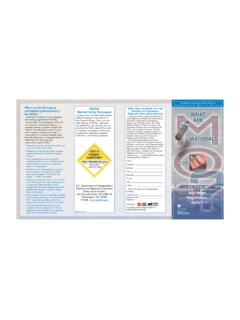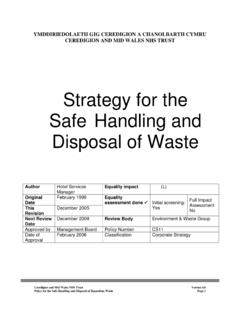Transcription of Infectious Subs. brochure - US Department of …
1 GUIDE TO CHANGESEFFECTIVE OCTOBER 1, 2006 FEDERAL REGISTERH azardous Materials: InfectiousSubstances; Harmonization With theUnited Nations Department of TransportationPipeline and Hazardous MaterialsSafety AdministrationInfectious subs . 10/2/2007 12:35 PM Page 1 Introduction .. 02 Why Are Infectious Substances Regulated in Transportation?.. 03 New Transportation Requirements forInfectious Substances .. 03 Changes to HMR; 49 CFR Parts 171, 172, 173, and 175 .. 03 New Classification System .. 04 Category A and Category B.
2 06 New and Revised Definitions.. 08 Classification Process .. 10 Examples of Category A Infectious Substances:UN2814, Infectious Substances Affecting Humans.. 12 Examples of Category A Infectious Substances:UN2900, Infectious Substances Affecting Animals Only.. 14 Table of ContentsInfectious subs . 10/2/2007 12:35 PM Page 2 Classification Scenarios .. 16 General Information.. 18 Part 172 Hazardous Materials Table Changes .. 20 Part 172 Special Provisions, Hazardous MaterialsCommunications Changes .. 22 Part 172 Security Plans.
3 24 Part 173 General Requirements for Shipments and Packagings Changes .. 26 Packing and Labeling of Category A .. 28 Packing and Marking of Category B .. 30 Part 175 Carriage by Aircraft Changes .. 32 Where to Learn More .. back cover1 TRANSPORTINGINFECTIOUSSUBSTANCESSAFELYI nfectious subs . 10/2/2007 12:35 PM Page 1 IntroductionInfectious subs . 10/2/2007 12:35 PM Page 2 Final rule effective October 1, 2006 Voluntary compliance beginning July 2, 20063 WHY ARE Infectious SUBSTANCES REGULATED IN TRANSPORTATION? An Infectious substance is regulated as a hazardousmaterial under the Department of Transportation s(DOT s) Hazardous Materials Regulations (HMR; 49 CFRP arts 171-180).
4 The HMR apply to any material DOTdetermines is capable of posing an unreasonable riskto health, safety, and property when transported incommerce. An Infectious substance must conform to allapplicable HMR requirements when offered for trans-portation or transported by air, highway, rail, or TRANSPORTATION REQUIREMENTS FORINFECTIOUS SUBSTANCESDOT s Pipeline and Hazardous Materials SafetyAdministration (PHMSA) published a final rule on June1, 2006, revising the requirements in the HMR appli-cable to the transportation of Infectious new requirements are effective October 1, UNDER THE NEW RULE APPLY TOPARTS 171, 172, 173, AND 175 OF THE HMR New classification system New and revised definitions Revised marking requirements Revised packaging requirements New shipping paper requirements New security plan requirements New carriage by aircraft requirementsInfectious subs .
5 10/2/2007 12:35 PM Page 34 New Classification SystemInfectious subs . 10/2/2007 12:35 PM Page 4 New classification criteria and packaging requirementsare now consistent with international standards andhelp clarify existing requirements to promote compli-ance. These revisions will ensure an acceptable level of safety for the transportation of Infectious substancesand facilitate domestic and international new classifications are based on criteria developedby the UN Committee of Experts working with theWorld Health Organization (WHO), the Centers forDisease Control and Prevention (CDC), medical profes-sionals, microbiologists, transportation professionals,and packaging technical experts.
6 They are consistentwith the requirements contained in the 13th and 14theditions of the United Nations Recommendations for theTransport of Dangerous Goods (UN Recommendations),the 2005-2006 edition of the International CivilAviation Organization Technical Instructions for theSafe Transport of Dangerous Goods by Air (ICAOT echnical Instructions), and the International MaritimeOrganization (IMO) Dangerous Goods new HMR requirements establish a two-tieredclassification system for Infectious substances Category A and Category arenow consistentwith internationalstandards5 TRANSPORTINGINFECTIOUSSUBSTANCESSAFELY cation SystemInfectious subs .
7 10/2/2007 12:35 PM Page 5 DIVISION ( Infectious substance ):Amaterial known or reasonably expected to contain apathogen. A pathogen is a micro-organism (includingbacteria, viruses, rickettsiae, parasites, fungi) or otheragent, such as a proteinaceous Infectious particle(prion), that can cause disease in humans or A:An Infectious substance in a formcapable of causing permanent disability or life-threatening or fatal disease in otherwise healthyhumans or animals when exposure to it occurs. Anexposure occurs when an Infectious substance isreleased outside of its protective packaging, resultingin physical contact with humans or must be based on the known medicalhistory or symptoms of the source patient or animal,endemic local conditions, or professional judgmentconcerning the individual circumstances of the sourcehuman or animal.
8 Category A poses a higher degreeof risk than Category substances, affecting animals,UN2900 Infectious substances, affecting humans,UN2814 Proper shippingnames andidentificationnumbersCategory A and Category BInfectious subs . 10/2/2007 12:35 PM Page 6 CATEGORY B:An Infectious substance not in a formgenerally capable of causing permanent disability orlife-threatening or fatal disease in otherwise healthyhumans or animals when exposure to it occurs. Thisincludes Category B Infectious substances transportedfor diagnostic or investigational SHIPPING NAME AND IDENTIFICATIONNUMBER:Biological substance , Category B, UN3373 (The proper shipping names Diagnostic Specimen or Clinical Specimen may be used in place of Biologicalsubstance, Category B until January 1, 2007.)
9 New classificationsystem:Category Aand Category B7 TRANSPORTINGINFECTIOUSSUBSTANCESSAFELYI nfectious subs . 10/2/2007 12:35 PM Page 78 Part 173 General Requirements for Shipmentsand PackagingsIn addition to Category A and Category B, there areother new and revised definitions in PRODUCT:A virus, therapeuticserum, toxin, antitoxin, vaccine, blood, blood component or derivative, allergenic product, or analogous product, or arsphenamine or derivative of arsphenamine (or any other trivalent arseniccompound) applicable to the prevention, treatment,or cure of a disease or condition of human beings or and Revised DefinitionsInfectious subs .
10 10/2/2007 12:36 PM Page 8 New definitionsDivision ( )9 TRANSPORTINGINFECTIOUSSUBSTANCESSAFELYCU LTURE:An Infectious substance containing apathogen that is intentionally propagated. Culturedoes not include a human or animal patient specimenas defined SPECIMEN:Human or animal materialscollected directly from humans or animals and trans-ported for research, diagnosis, investigational activi-ties, or disease treatment or prevention. Patientspecimen includes excreta, secreta, blood and itscomponents, tissue and tissue swabs, body parts,and specimens in transport media ( , transwabs,culture media, and blood culture bottles).






